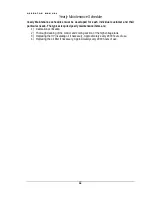
O P E R A T O R M A N U A L
16
14.
Uncoil the GROUND CABLE from the reel assembly and connect to a solid station ground.
Clamp securely to the trolley ground clamp.
15.
Uncoil the HV Output cable from the reel and connect the output lead to the test sample. Be
sure that there is enough clearance to grounded objects for the expected test voltage. The
minimum clearance in air is 10 kV ac/inch.
16.
Place the OUTPUT MODE in the HIPOT position
17.
With the OUTPUT control at zero (zero start interlock engaged), depress the HV ON
pushbutton. The HV ON light will glow. At this time the pump and fan on the high voltage
section will also energize.
18.
Increase the output by operating the HIGH VOLTAGE control to the RAISE position until
the desired output voltage is reached. Raising the output too fast with large capacitive loads
may trip the output overload. Observe the OUTPUT PERCENT meter to rough in the set
voltage. Please recognize that the output cycle is: 100 seconds for a full sine wave @.01
Hz, 50 seconds fro a full sine wave @ .02 Hz, 20 seconds for a full sine wave @ .05 Hz,
and 10 seconds for a full sine wave @ .1 Hz. . To set the output voltage you may need
more than one cycle to read the output accurately.
19.
Maintain the output voltage for the test time specified in your standard procedures.
20.
After the test is complete, depress the HIGH VOLTAGE control in LOWER position,
allowing the load to return to zero and the unit to cycle for about 60 more seconds prior to
depressing the HV OFF pushbutton. Allowing the unit to cycle for some time allows for the
complete discharge of the load and avoiding the normal self recharge that capacitive loads
will exhibit.
21.
If the test sample fails during the test, the overload circuit will de-energize the high voltage.
Should an overload occur, the normal sine wave cycle is interrupted and the load may bleed
down much more slowly than when the unit is cycling normally. Depress the FAULT/RESET
pushbutton to resume testing.,
22.
Prior to removing the output cable from the load, observe that the output voltmeter is
at zero, and then use a GROUND STICK to positively ground the test sample
.
It should be noted that the VLF series test sets are not intended to be used
on vacuum bottles or switchgear without cables connected. The VLF
requires a minimum of .01uF load capacitance to achieve full output. If the
capacitance of the load is too low, the kilovolt meter will not read the actual
peak output and damage to the unit (and/or load) may result.














































